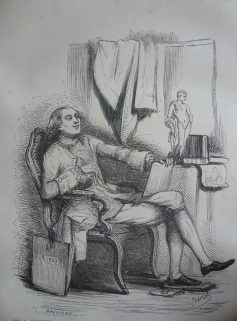
Sarrasine
.THE HUMAN COMEDY – Honoré de Balzac Tenth volume of works of Honoré de Balzac edited by widow André Houssiaux, publisher, Hebert and Co, successors, 7 rue Perronet – Paris (1877)
Scenes from Parisian life

Sarrasine
SARRASINE
Work by Honoré de Balzac written in Paris in November 1838
Signed by the author TO MONSIEUR CHARLES DE BERNARD DU GRAIL
Analysis of the work Like Facino Cane, Sarrasine is a tale written long before the great Scènes de la vie parisienne novels, and is a specimen of Balzac’s entirely different “manner”. First, this tale was written in 1830 and first appeared in the Revue de Paris of the same year. It therefore belongs to the period when Balzac had not yet organized his work, and is presented above all as a specialist in storytelling, even called a “contier” in those days. In the stories of this period, Balzac makes no claim to be the painter of an entire society, an ambition that will only come to him later: there is therefore no circulation of characters from one work to the next as in the other novels and short stories of The Human Comedy later corrections have eliminated this particular feature, but Sarrasine as Pierre Grassou and Facino Cane have not been included in this “update”. Finally, Sarrasine, a tale in its purest form, could never be definitively classified by Balzac in any of the divisions of his work, Sarrasine is treated as a “filler” that Balzac attributes to the Etudes philosophiques, sometimes to a series of Studies in 19th-century manners. So don’t put too much stock in this brilliant exercise in style, which could have been written by any contemporary author. Balzac, very proud of the “audacity” of his subject, would later invite his impresario, Félix Davin, to compare Sarrasine with La Fille aux yeux d’or as a painting of abnormal passion. It’s a misrepresentation. Sarrasine is not a homosexual adventure, but the story of a deception. It’s strange that some commentators have fallen victim to Balzac’s publicity stunt, and have consequently taken pains to see in this novella intentions that Balzac never had.
The story At an evening party in Paris, the story’s narrator is surprised by the appearance of a little old man, apparently a hundred years old, who is being carried around with infinite care and respect. We tell him the story of this fragile puppet: he’s a famous castrato from Venice, who played female roles in the Papal States, as was the rule at the time, and was famous for his voice and beauty. The young French sculptor Sarrasine, unaware of Italian customs, falls in love with the marvelous opera singer at the theater, and is applauded by the entire audience. The castrato’s comrades, noticing this passion, have a lot of fun with this mistake and make it last by organizing a party in which all those present become accomplices in this misunderstanding. Despite the castrato’s reticence and fear, Sarrasine understands nothing, becomes increasingly enraged and plans to kidnap the singer. A word teaches him the truth. He persists in his plan out of rage, carries out the planned kidnapping, but only to make the transvestite a furious scene that shows enough that there was nothing abnormal about this pursuit. Sarrasine is about to kill the man who deceived him when he himself is murdered by the henchmen of a cardinal, protector of the irresistible star. The centenarian being paraded through the salons is the castrato who has become very old and very rich thanks to the generosity of a number of enthusiasts. He was the source of the family’s great fortune.
 Source analysis: Preface and story compiled from the complete works of the Comédie Humaine (tome XVI) published by France Loisirs 1986 under the auspices of the Société des Amis d’Honoré de Balzac.
Source analysis: Preface and story compiled from the complete works of the Comédie Humaine (tome XVI) published by France Loisirs 1986 under the auspices of the Société des Amis d’Honoré de Balzac.
The characters Madame de Rochefide: Béatrix-Maximilienne-Rose de Castéran de Rochefide, wife of Arthur de Rochefide . Comte de Lanty: married the niece of castrato Zambinella. The couple had two children, Marianina and Filippo. Ernest-Jean Sarrasine Sculptor born in 1736, murdered in 1758. Zambinella: Born in 1738, an uncle of the Lantys, he worked as a castrato in Rome before retiring to Paris.
Source: Félicien Marceau, “Balzac et son monde”, Gallimard.
No Comments